A point particle of mass M is attached to one end of a massless rigid non-conducting rod of length L. Another point particle of the same mass is attached to the other end of the rod. The two particles carry charges +q and -q respectively. This arrangement is held in a region of a uniform electric field E such that the rod makes a small angle theta (say of about 5 degree) with the field direction, fig. Find an expression for the minimum time needed for the rod to become parrallel to the field after it is set free.
 Solution in Punjabi
Solution in Punjabi
Step by step video & image solution for A point particle of mass M is attached to one end of a massless rigid non-conducting rod of length L. Another point particle of the same mass is attached to the other end of the rod. The two particles carry charges +q and -q respectively. This arrangement is held in a region of a uniform electric field E such that the rod makes a small angle theta (say of about 5 degree) with the field direction, fig. Find an expression for the minimum time needed for the rod to become parrallel to the field after it is set free. by Physics experts to help you in doubts & scoring excellent marks in Class 12 exams.
Updated on:21/07/2023Topper's Solved these Questions
- ELECTRIC FIELDBOOK - MODERN PUBLICATIONCHAPTER - ELECTRIC FIELDEXERCISE - EXERCISE
95 Videos
- ELECTRIC CURRENT. RESISTANCE AND E.M.FBOOK - MODERN PUBLICATIONCHAPTER - ELECTRIC CURRENT. RESISTANCE AND E.M.FEXERCISE - EXERCISE
64 Videos
- ELECTRIC POTENTIALBOOK - MODERN PUBLICATIONCHAPTER - ELECTRIC POTENTIALEXERCISE - EXERCISE
38 Videos
Similar Questions
In defining electric field due to a point charge, the test charge has to be vanishingly small. How this condition can be justified, when we know that charge less than the on an electron or a proton is not possible?
View SolutionWhat is drift velocity of electrons? How do you explain the flow of current in a conductor based on this?
View SolutionFind an expression for line integral of electric intensity.
View SolutionA point particle of mass M is attached to one end of a massless rigid non-conducting rod of length L. Another point particle of the same mass is attached to the other end of the rod. The two particles carry charges +q and −q respectively. This arrangement is held in a region of a uniform electric field E such that the rod makes a small angle θ (say of about 5 degree) with the field direction, fig. Find an expression for the minimum time needed for the rod to become parrallel to the field after it is set free.

View SolutionA particle is attached to an end of a rigid rod. The other end of the rod is hunged and the rod rotates always remaining horizontal. Its angular speed is increasing at contant rate. The mass of the particle is m . The force exerted by the rod on the particle is →F , then:
View SolutionA particle of mass m is attached to one end of missless rigid non-conducting rod of length l. Another particle of the same mass is attached to the other end of the rod. Two particles carry charges +q and -q . This arrangement is held in the region of uniform electric field E such that the rod makes and angle θ(<5∘) with the field direction. Find an expression for the minimum time that is needed for the rod to become parallel to the field after it is set free.
View SolutionA point mass M is attached to one end of a masslesa rigid non-conducting rod of length L. Another equal point mass is attached to the other end of the rod. The two particles carry charges +q and −q respectively. This arrangement is held I the region of uniform electric field E such that the rod makes a small θ (say about 5∘) with field direction. Moment of inertia of the rod is I.
Now answer the question
The ratio θα is
View SolutionA point mass M is attached to one end of a masslesa rigid non-conducting rod of length L. Another equal point mass is attached to the other end of the rod. The two particles carry charges +q and -q respectively. This arrangement is held I the region of uniform electric field E such that the rod makes a small theta (say about 5^(@) ) with field direction. Moment of inertia of the rod is I. Now answer the question Time period of SHM of the given system is
View SolutionA point mass M is attached to one end of a masslesa rigid non-conducting rod of length L. Another equal point mass is attached to the other end of the rod. The two particles carry charges +q and −q respectively. This arrangement is held I the region of uniform electric field E such that the rod makes a small θ (say about 5∘) with field direction. Moment of inertia of the rod is I.
Now answer the question
Time period for the rod to become parallel to E is
View SolutionA particle is attached to the lower end of a uniform rod which is hinged at its other end as shown in the figure. The minimum speed given to the particle so that the rod performs circular motion in a vertical plane will be ___________ (in m/s)
[length of the rod is l=5m consider masses of both rod and particle to be same, g=10m/s2]

View SolutionA uniform rod of mass m and length L is hinged at one of its end with the ceiling and another end of the rod is attached with a thread which is attached with the horizontal ceiling at point P. If one end of the rod is slightly displaced horizontally and perpendicular to the rod and released. If the time period of small oscillation is 2pisqrt((2lsintheta)/(xg)) . Find x.
View SolutionTwo point masses, m each carrying charges -q and +q are attached to the ends of a massless rigid non - conducting wire of length L. When this arrangement is placed in a uniform electric field, then it deflects through an angle theta . The minimum time needed by the rod to align itself along the field is
View SolutionTwo charged particles each of mass 9.8 g and charges + 20 μ C and −20μ C are attached to the two ends of a massless and rigid uniform non-conducting rod of length 50 cm. This arrangement is held in a uniform electric field of 12.1 NC−1 such that the rod makes a very small angle with the field direction. If the rod is set free the minimum time needed for the rod to become parallel to the direction of the electric field is ............ seconds.
View SolutionA point particle of mass m is attached to one end of massless rigid non-conducting rod of length l. Another point particle of same is attached to the other end of the rod. The two particles carry equal charges +q and -q respectively. This arrangement is held in a region with the field E such that the rod makes an angle with the field direction :
View SolutionA particle is attached to the lower end of a uniform rod which is hinged at its other end as shown in the figure. Another identical particle moving horizontally, collides inelastically and sticks to it. The minimum speed of moving particle so that the rod with particle performs circular motion in a vertical plane will be: [length of the rod is l, consider masses of both particle and rod to be same]

View SolutionA particle is attached to an end of a rigid rod. The other end of the rod is hunged and the rod rotates always remaining horizontal. Its angular speed is increasing at contant rate. The mass of the particle is m . The force exerted by the rod on the particle is →F , then:
View Solution
